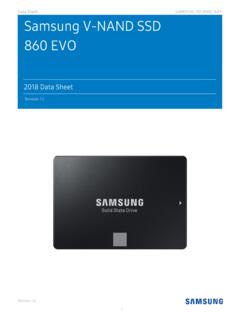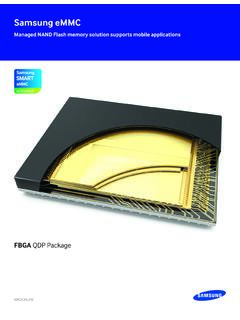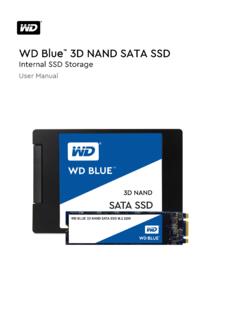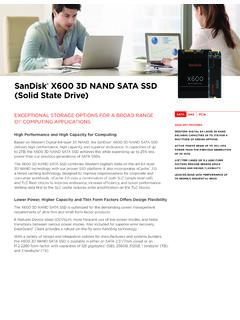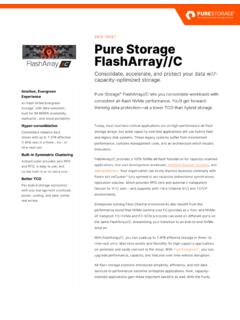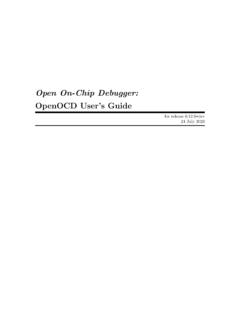Transcription of Over-Provisioning Benefits for Samsung Data Center SSDs
1 Figure1: Wear LevelingBackground Unlike Hard Disk Drives (HDDs), Solid State Drives (SSDs) store electrons on nand cells when writing data . With nand flash , the stored data cannot be overwritten when new data is stored or erased. Since the writing and erasing operations (Program/Erase) of an SSD are carried out in different units, referred to as pages and blocks respectively, multiple cycles of Program and Erase are inevitable in writing and managing data . As more of such cycles are repeated, some electrons get trapped between cells and over time, these cells reach the end of their lifetime and encounter durability issues.
2 Such a phenomenon is called the wear-out of cells and is responsible for the physical limits of the lifetime of nand . Therefore, proper management of nand is crucial in extending the lifetime of the SSD. When data is repeatedly written in a certain area, the corresponding cells quickly wear out, so such repeated writing to the same cells should be prevented. Wear-leveling, a function that prevents repeated writing operations to a certain region, enables cells to be utilized evenly by swapping the blocks exposed to a high number of P/E cycles with free blocks, allowing the user to use the SSD longer under given conditions.
3 Over-Provisioning Benefits for Samsung data Center SSDsOver- provisioning is a function that provides additional capacity specifically for data to be erased from an SSD, without interrupting system performance. The dedicated Over-Provisioning space may be adjusted to the user s preference, delivering Benefits that include faster speed and longer SSD life. This white paper provides in-depth information about Over-Provisioning , as well as instructions on how to adjust the Over-Provisioning space, and considerations to be made before doing PaperFree SpaceHigh PEInvalid BlockLow PEFree BlockWithout Wear-LevelingWith Wear-LevelingHigh ECLow ECWhat is OP ( Over-Provisioning )?
4 Since overwriting is impossible with nand flash , existing data must first be erased in order to write new data to that cell, which slows down overall write performance of the SSD. Generally, it takes longer to erase data than to write it because, as mentioned previously, write operations are carried out in pages while erase operations are executed in blocks. To alleviate this decrease in write performance, a process called garbage collection (GC) is implemented to create free blocks within the SSD. This technology secures free blocks by collecting valid pages into a single location and erasing the blocks consisting of invalid pages.
5 However, this too may sometimes result in slower performance in the unexpected case that garbage collection interferes with the host write. Therefore, free space in the SSD is required to allow the firmware (FW) feature to run smoothly. This process in which extra space is allocated is called Over-Provisioning (OP).As previously stated, Over-Provisioning refers to a function that secures extra space to allow for efficient use of the SSD by allo-cating a certain amount of the SSD s nand flash to an Over-Provisioning space. This space can only be accessed by the SSD s con-troller and not by the host.
6 Consisting of free blocks only, the OP region assists in efficient delivery of free blocks when wear-lev-eling or garbage collection is in progress and contributes to improved performance and lifetime of the SSD. Typically, Samsung DC SSDs are set to provide of capacity for OP by default, but the user can manually adjust the size of the space if he or she requires additional OP depending on the user environment. Figure 2: Garbage CollectionFactory OPFactory OP + User OPUser SpaceUser SpaceValid PageFree PageInvalid PageStep1 Collect valid pagesStep2 Erase Blocks consisting of invalid pagesBlock ABlock BERASEM odify OPFree BlockOP Ratio Formula: OP (%) = ((Physical Capacity User Capacity) / User Capacity) * 100 Ex) When 120 GB of a 128 GB SSD is used as the user capacity while 8 GB is assigned to the OP, the OP (%) is ((128 120) / 120) * 100 = %.
7 Although there is no difference between the sequential and random write performance for fresh-out-of-the-box (FOB) nand , the random write does not perform as well as the sequential write once data has been written over the entire space of the nand . Random writes, smaller in size than sequential writes, mix valid and invalid pages within blocks, which causes frequent GC and results in decreased performance. If the OP is increased, more free space that is inaccessible by the host can be secured, and the resulting efficiency of GC contributes to improved performance.
8 The sustained performance is improved in the same manner. From the aspect of the lifetime of the product, internal operations such as GC cause the number of nand writes to become greater than that of the host writes, and this also results in an increase in WAF (Write Amplification Factor), defined as the ratio of host writes to nand writes. An increase in the WAF value indicates that unexpected nand use is growing, and the lifetime of the product may be shortened before reaching the total byte written (TBW). A sufficient OP space decreases the nand usage by improving the efficiency of internal nand operations.
9 It has the advantage of increasing the daily workload per day (DWPD) usable during the warranty period. How do I calculate the OP ratio?What are the advantages of increasing OP?Figure 4. Random Write Performance (QD32) per User OP for SATA / NVMe DC SSDUser OP0%10%20%2919452049340504060302010[K IOPS]User OP0%10%20%814717489201119025020015010050 [K IOPS]860 DCT883 DCT983 DCT983 ZETThe graphs below show the estimated DWPD for each warranty by allotting additional user OP for Samsung s data Center products (860/883/983 DCT, 983 ZET). The values in the graphs were calculated using the formula below and is a calculated value of each SSD, not a guaranteed value.
10 The DWPD rises in accordance with the increase in the OP rate. Users can find the numbers needed for the calculations below through attributes, which are explained in more detail in the next section Estimating life-time of an SSD using attributes. Example for Samsung DCT Series WAF =Host Write AmountPhysical Write AmountDWPD = nand PE Cycle * Raw DensityLogical Density * 365 * Warranty Years * WAFfor 883 DCT 960 GBUser OP (Density)0% (960GB)10% (872GB)20% (800GB) [DWPD]for 983 DCT 480 GBUser OP (Density)0% (480GB) (395GB)28% (375GB) [DWPD]Warranty 3yrsWarranty 5yrsUser OP (Density)0% (960GB)10% (872GB)20% (800GB) [DWPD]for 860 DCT 960 GBUser OP (Density)0% (960GB)10% (872GB)20% (800GB) [DWPD]for 983 DCT 960 GBUser OP (Density)0% (480GB)20% (800GB)28% (750GB) [DWPD]for 983 ZET 960 GBFigure 5.
